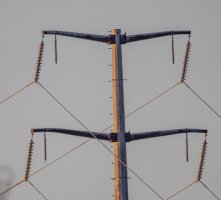That commentary was truly weird. Either she has no idea what she is talking about or just didn't spit out what she was trying to say correctly. In my experience, if there is any difference in atmospheric behavior between lenses, it would be the other way around. I have occasionally seen situations where small super zoom (e.g. Panasonic FZ80) would be more distorted, but sharper than something like the EF 800 f/5.6. Not sure of the cause, but I suspect it has to do with the area of atmosphere intercepted and the larger lens tends to average the distortion over a larger area whereas the small lens is looking through a smaller cross-section of air that may be bent, but some sharpness still survives. Neither image is particularly useful, but just an observation. I have also noticed similar averaging behavior with exposure time. Very short exposures will show more distortion and less blurring, whereas very long exposures will be very blurred, but not as distorted and that makes perfect sense in the presences of dynamic thermal distortion. None of that supports what the Pangolin lady said, but then, I have not been on Safari in Africa

.

